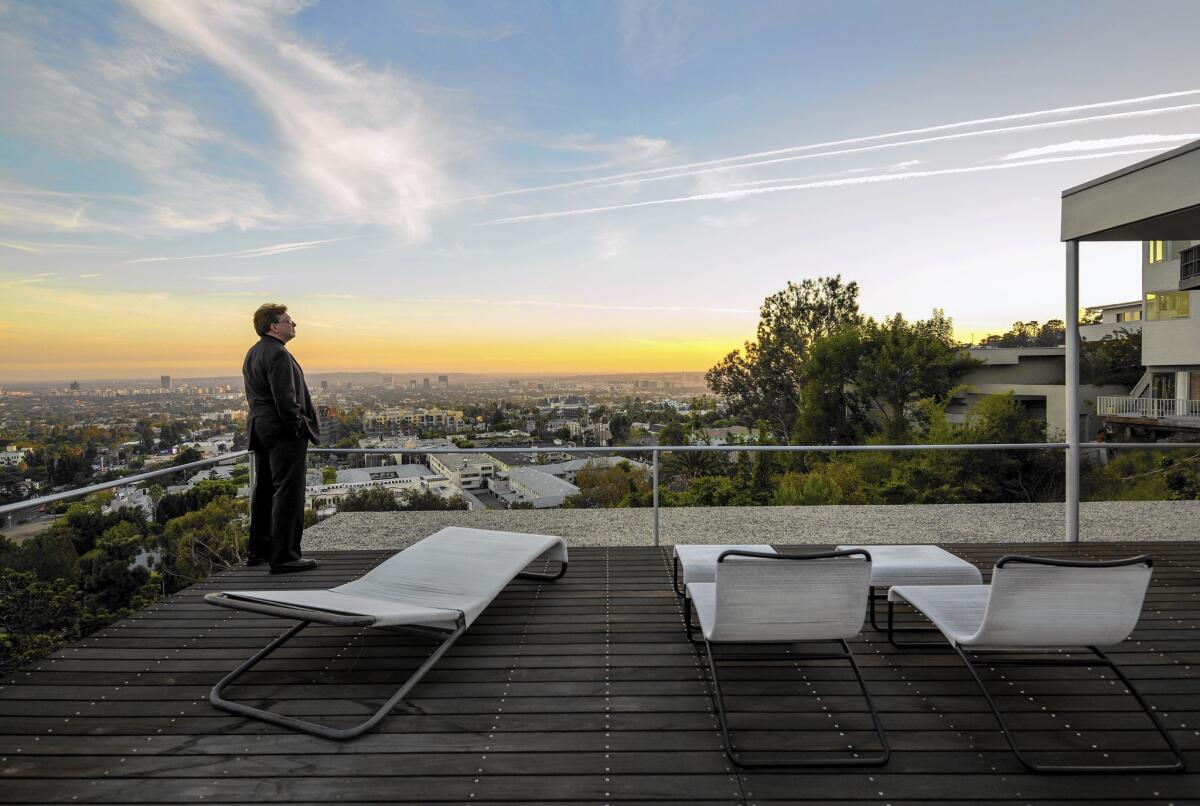Devo rocker’s new trio works to restore Neutra’s Kun House

Musician Gerald Casale knows the value of a second chance.
A founding member of the new wave band Devo, he had planned to buy Richard Neutra’s Kun House nearly 30 years ago. “I had been a fan of Neutra since graduating from Kent State University, and I was going to buy [the Kun House] in 1985 for $250,000, and Devo lost their deal with Warner Brothers before it went into escrow,” leaving him without enough funds, says Casale.
About seven years ago, Casale got his second chance. He now owns the two-bedroom, two-bathroom home. He, modernist preservationist and artist James Rega and designer and researcher Christopher Steele have been creating a time warp at the 3½-story house perched on the rock face of Nichols Canyon in the Hollywood Hills.
“What we’re trying to do is defend the vision of what we consider a great artist,” Rega says. They intend eventually to open the house to architectural students and design groups.
Photos of the 1,732-square-foot pre-war house revealed that it had been a clean, inviting space, but, the three partners say, it had strayed too far from Neutra’s design. “The house was not in an amazing condition. Nothing horrible, though,” Rega says. “It’s gone through various remodels where weird things happened: moving walls, trying to enlarge bedrooms, the kitchen and bathrooms had all been long erased.”
In a bid to restore Neutra’s hand in the architecture, Rega and Steele, along with many other collaborators and artisans, formed an informal consortium they called the Museum of Design and Mechanical Arts, or MDMA, with the mission to restore the Kun House as it was in 1936, when it was finished — and sometimes taking it even further using some Neutra designs that had not been built.
Nothing was beyond the group’s notice: light switches, air grills, floor treatments — all returned to an early 20th century aesthetic.
The team kept the original casement windows throughout the home but replaced all the glass. “I found old pieces of ribbed, really wavy glass in the Lovell House garage and used those as a model,” says Rega, whose team of artisans had to use a low-iron glass to re-create that look. The pre-war Lovell House, also a Neutra design, shares many characteristics with the Kun House.
MDMA managed the same feat with the steel sliding door that stands guard over the focal point of the house: the roof deck, where magnificent views from Hollywood out into the ocean can still be seen. Modeled after the Miller House in Palm Springs by Neutra (“The woman fixing the Miller house still had the original door,” explains Rega), the Kun House sliding doors intentionally showed weld marks because technology at the time didn’t allow the smooth joinery as we see today.
“You see where it welded up too much and it’s wavy and lumpy,” Rega says. “We like all of that. It feels real. It feels no different from the way it was done at that time.”
On the roof deck, the group revived the simple metal railing Neutra had installed and added three roped VKG Terrace lounge chairs and ottomans from 1939. Rega says, “That’s probably as midcentury as we’re going to get,” so all the furniture should be from the 1920s, ‘30s and ‘40s.
Inside, the furniture comes from MDMA’s collection, all from the 1920s to the early ‘40s, includingfurniture and lighting designed by Alvar Aalto, Gerrit Rietveld, and Walter von Nessen. The walls are lined with art by Wassily Kandinsky, Paul Klee and László Moholy-Nagy.
In the kitchen and dining room, MDMA revitalized the Neutra-style cabinets, complete with the architect’s signature flush pulls. Unable to find an appropriate 1930s electric stove, Rega cannibalized a modern one and completed the look with period Bakelite knobs.
MDMA isn’t always so tyrannical, however. Behind the cabinetry hides a modern fridge and dishwasher. “If those things aren’t going to work, nobody’s going to tolerate it,” says Rega, who accepts the limits of his obsession. In the bathroom, the 1930s fixtures, a Breuer-esque tubular sink stand and linoleum floors hide all-new plumbing and a heated floor.
In some cases, MDMA went so far as to continue Neutra’s work by realizing his designs, such as the built-in daybed in the living room and the built-in side desks in the bedroom. “These were all created from scratch,” says Rega, who based the proportions of the king-sized bed and the nightstands from the Neutra-designed Darling residence in San Francisco.
It’s the team’s thoroughness that yielded something serene and timeless, according to Casale, whose role was as owner, not restorer. “Walking around in here and being in here, you realize that Neutra developed these proportions based on a regular human being, not the oversized dimensions we have today. Here’s how much space you need to walk through a door. Here’s how much you need to turn around. Here’s how much you need to lie down. And no more. It’s not the modern American McMansion mentality.”
More to Read
The biggest entertainment stories
Get our big stories about Hollywood, film, television, music, arts, culture and more right in your inbox as soon as they publish.
You may occasionally receive promotional content from the Los Angeles Times.










